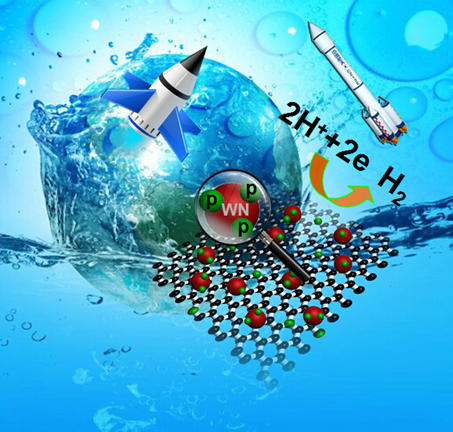Angew. Chem. Int. Ed. 2015, 54, 6325 –6329

Haijing Yan, Chungui Tian,* Lei Wang, Aiping Wu, Meichen Meng, Lu Zhao, and Honggang Fu*, Phosphorus-Modified Tungsten Nitride/Reduced Graphene Oxide as a High-Performance, Non-Noble-Metal Electrocatalyst for the Hydrogen Evolution Reaction. (Angew. Chem. Int. Ed. 2015, 54, 6325 –6329)
The tungsten-based compounds are an important family of catalysts. The combination of W with S, C, N, and P can form active catalysts useful for methanol oxidation, the ORR, and DSSCs. WN (W2N) are known as original hydrodesulfurization (HDS) catalysts owing to their Pt-like characteristics. The reversible binding and dissociation of H2 represents a possible mechanistic commonality of HDS and HER, implying that the WN should be potential catalyst for HER. The similar electronic structure ofWwith Mo has also supported the speculation. Theoretical calculations predict that the hydrogen is inclined to adsorb on the metal nitride surface, making the reaction easily happen. Recently, amorphous W2N nanoparticles (NPs) have been developed as a catalyst for the HER in acidic solutions, but with relative low activity. Therefore, ways to enhance the catalytic activity of tungsten-nitride based HER catalysts remains a challenge. Phosphorus-modified tungsten nitride/reduced graphene oxide (P-WN/rGO) is designed as a high-efficient, lowcost electrocatalyst for the hydrogen evolution reaction (HER). WN (ca. 3 nm in size) on rGO is first synthesized by using the H3[PO4(W3O9)4] cluster as a W source. Followed by phosphorization, the particle size increase slightly to about 4 nm with a P content of 2.52 at%. The interaction of P with rGO and WN results in an obvious increase of work function, being close to Pt metal. The P-WN/rGO exhibits low onset overpotential of 46 mV, Tafel slope of 54 mV dec-1, and a large exchange current density of 0.35 mA cm-2 in acid media. It requires overpotential of only 85 mV at current density of 10 mA cm-2, while remaining good stability in accelerated durability testing. This work shows that the modification with a second anion is powerful way to design new catalysts for HER.The enhanced performance of P-WN/rGO should be relative with the interaction of P with rGO and WN. Also, we think that the performance of PWN/rGO can be further improved by loading the catalyst on Ti plate with high loading, or by growth of the catalyst on carbon cloth to form a 3D catalyst. Further work is under way. Our work shows that the modification with second anions is powerful way to design robust catalysts for the HER.
